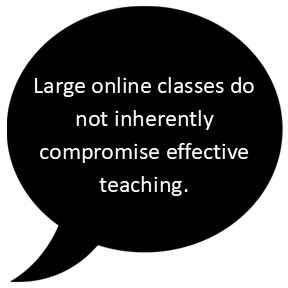Authors: Mary Otto and Jennifer Staton, University of Central Florida
Editor: Dr. Denise Lowe, University of Central Florida
Dear ADDIE,
I’m teaching a very large online course this semester, and I’m honestly at my limit. Between the nonstop discussion posts, grading assignments, and answering what feels like hundreds of emails, I’m struggling to keep up. I want my students to feel seen and supported, but I’m starting to worry that I’m just going through the motions.
How do instructors manage such large online classes without losing their minds – or their connection to the students?
Signed,
Overwhelmed but Still Caring
Dear Overwhelmed,
Managing a large online course is a complex task, and your struggle to balance being present and responsive with maintaining your well-being is both valid and commendable. Fortunately, there are pedagogically sound strategies that can help you support student needs while also establishing sustainable boundaries.
- Start by creating opportunities for meaningful interaction. Collaborative assignments and discussion boards can foster student-to-student and student-to-instructor connections, thereby enhancing emotional and cognitive engagement (Yang & Ghislandi, 2024). To keep things fresh and efficient, consider incorporating various technologies—such as podcasts, simulations, or storytelling activities—to support diverse ways of processing and engaging with content (Hartshorne, 2014).

- Research indicates numerous benefits of collaborative learning (Hartshorne, 2014), but encouraging engagement and teamwork in large online classes can be challenging. Instructors often struggle to find time to engage with and assess discussion posts, as well as to foster active group participation. To maximize the impact of online collaborative learning, clearly define group roles, highlight the workplace relevance of teamwork, and scaffold activities to build collaborative skills. (Hartshorne, 2014). Explicitly guide the students through the necessary group actions, such as forming group rules and communication plans before major assignments, and incorporate peer evaluations into grading at the end of the term.
- Grading is a significant challenge in large classes, so leverage tools that lighten the load. Use rubrics or templates that allow students to self-check before submitting—this not only saves you time but also helps them take ownership of their learning (Elison-Bowers et al., 2011). For formal assessments, automate what you can through your learning management system (LMS). For informal check-ins, think peer reviews, group projects, or low-stakes self-assessments. And remember: not everything has to be graded. Focus your energy where it matters most—on what aligns with your student learning goals (Hartshorne, 2014).
To ease the burden of discussion grading, consider using a platform like Yellowdig. This tool facilitates interactive, media-rich course discussions and provides engagement analytics to support meaningful student participation. Many institutions integrate Yellowdig with their LMS, allowing for automated grade transfer and reducing the need for manual grading. This shift enables instructors to spend more time connecting with students. For an example of institutional support, refer to the Yellowdig Faculty Guide from the Center for Distributed Learning (CDL) at the University of Central Florida.
Though large, online classes may seem like obstacles to educational quality, they don’t inherently compromise effective teaching or learning outcomes. (Elison-Bowers et al., 2011) Thoughtfully implemented strategies like these will help you manage the workload without compromising instructional impact.
What other ideas or plans for managing large online courses have you applied or are exploring at your higher education institution? Please share your thoughts with our TOPkit community on LinkedIn!
References
Elison-Bowers, P., Sand, J., Barlow, M. R., & Wing, T. J. (2011). Strategies for managing large online classes. International Journal of Learning, 18(2), 57–66. https://doi.org/10.18848/1447-9494/CGP/v18i02/47489
Hartshorne, R. (2014). Managing large online courses: Pedagogical approaches and technological tools. In Atsusi Hirumi (Ed.). Online and Hybrid Learning Trends and Technologies. (pp. 17-30). International Society for Technology in Education.
Yang, N., & Ghislandi, P. (2024). Quality teaching and learning in a fully online large university class: a mixed methods study on students’ behavioral, emotional, and cognitive engagement. Higher Education, 88(4), 1353–1379. https://doi.org/10.1007/s10734-023-01173-y
